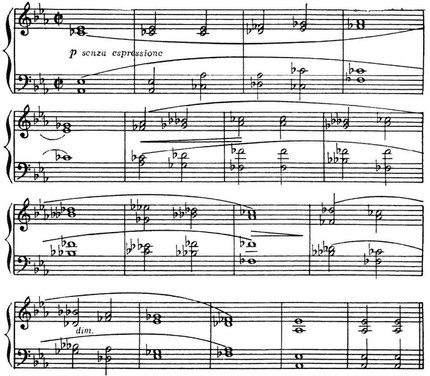
Everyday scale |
The living scale, everyday mode, – a sound system with a structure (in tones) 1-1-1 / 2-1-1-1 / 2-1-1-1 / 2-1-1, which forms the modal basis of Rus. Wed-century. music. The name comes from “Obikhod” – a collection of melodies used in cult practice. O. h. characteristic quart structure:

Trichords within each quart called. “consent”. If in the European octave (= 8) has seven steps (8-1), then in the tetrachord (“in a quart”) there are three of them (4-1). All accords have the same interval structure (in tones: 1-1). Each agreement has its own name (“simple”, “gloomy”, “bright”, “cracked”). The quartic nature of the structure is also manifested in the system of names of the steps, where the repeating (i.e., understood as melodically single-functional) steps are separated from each other by a fourth (counting from two middle concordances to the edges of the scale). In O.’s design h. there are elements of similarity with the structure of other Greek. “perfect system”. O. h. can also be considered as a combination of major tetrachords, pentachords, hexachords at a distance of a fourth. Specificity of O. z. – the possibility of an interval of a reduced octave between the steps C (“tsa”) and M (“gloomy with a crest”), moreover, within the same system, without modulation or deviation (accords within the O. z. system have the same meaning as the lower and upper tetrachords within the Ionian mode system).
Samples O. z. we find not only in the church. music, but also in folk music (Russian song “Young Molodka, Molodka” from the collection of M. A. Balakirev, see an example in Art. Sound system).
As a reflection of one or the other, they are also found among Russian composers. schools (N. A. Rimsky-Korsakov, 3rd solo of the deacon from the 2nd act of the opera The Night Before Christmas).
In conditions of polyphony (mainly in composer practice), O. z. acquires the meaning of a fret that is brightly peculiar in color, the chord to-rogo includes harmonies that are inexplicable from the positions of the west. major-minor system (the ces-moll chord in the following example).

Sometimes O.’s use h. merges with tonal variability, akin to deviations, or causes a deviation itself (often in Russian dance tunes, based on the STDT scheme; cf. “Russian Dance” from A. Khachaturian’s ballet “Gayane”). In modern music also uses a chord with a reduced octave.

I. F. Stravinsky. “Sacred spring”. “Invocation to the Forefathers”.
O. h. it is also found in the music of other peoples (for example, among the Kirghiz). Akin to it is the use of the Mixolydian mode in modal harmony of the 16th-17th centuries. (where subsemitonium modilis was added to the main scale f1 – e1 – d1 – c 1 – h – a – g from below). The appearance of O. z. in different era and in non-contiguous ethnographic. groups is explained by the fact that the structure of O. z. reflects one of the typological patterns of certain types of melodic. frets – the tendency of the steps of the high register to decrease, and the low – to increase, especially when the fret scale consists of narrow-volume melodics. components.
References: Razumovsky D., Church singing, in Russia …, no. 1-3, M., 1867-69; Findeizen N., Essays on the history of music in Russia, vol. 1, M., 1928; Belyaev V., Old Russian musical writing, M., 1962; Sposobin I., Lectures on the course of harmony, M., 1969.
Yu. N. Kholopov




